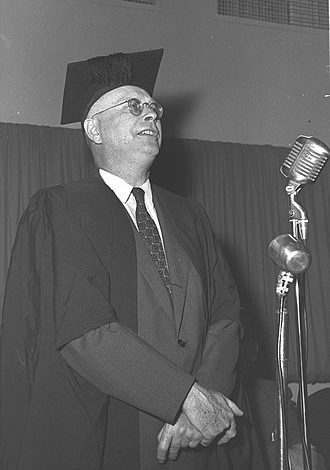William F. Albright

William Foxwell Albright (May 24, 1891– September 19, 1971) was an American archaeologist, biblical scholar, philologist, and expert on ceramics.
Albright was born on May 24, 1891, in Coquimbo, Chile,[17] the eldest of six children of the American evangelical Methodist missionaries Wilbur Finley Albright and Cornish-American Zephine Viola Foxwell.[18] Albright was an alumnus of Upper Iowa University.[19] He married Ruth Norton (1892–1979)[citation needed] in 1921[20] and had four sons. He received his Doctor of Philosophy degree from Johns Hopkins University in Baltimore, Maryland, in 1916 and took a professorship there in 1927, remaining as W. W. Spence Professor of Semitic Languages from 1930 to his retirement in 1958. He was also the Director of the American School of Oriental Research in Jerusalem, 1922–1929, 1933–1936, and did important archaeological work at sites in Israel such as Gibeah (Tell el-Fûl, 1922) and Tell Beit Mirsim (1926, 1928, 1930, and 1932).[21]
Tumulus 2 (Jerusalem), excavated by Albright in 1923. His excavation trench is still visible at the top of the structure.
Albright became known to the public for his role in the authentication of the Dead Sea Scrolls in 1948,[22] but made his scholarly reputation as the leading theorist and practitioner of biblical archaeology, “that branch of archaeology that sheds light upon ‘the social and political structure, the religious concepts and practices and other human activities and relationships that are found in the Bible or pertain to peoples mentioned in the Bible.”[23] Albright was not, however, a biblical literalist; in his Yahweh and the Gods of Canaan, for example, he argued that Yahwism and ancient Caananite religion had a reciprocal relationship, in which “both gained much in the exchange which set in about the tenth century and continued until the fifth century B.C”.[24]
Although primarily a biblical archaeologist, Albright was a polymath who made contributions in almost every field of Near Eastern studies: an example of his range is a BASOR 130 (1953) paper titled “New Light from Egypt on the Chronology and History of Israel and Judah”, in which he established that Shoshenq I—the Biblical Shishaq—came to power somewhere between 945 and 940 BC.
A prolific author, his major works include Yahweh and the Gods of Canaan, The Archaeology of Palestine: From the Stone Age to Christianity, and The Biblical Period from Abraham to Ezra. He also edited the Anchor Bible volumes on Jeremiah, Matthew, and Revelation.
Throughout his life Albright was honored with numerous awards, honorary doctorates, and medals, and was given the title “Yakir Yerushalayim” (Worthy Citizen of Jerusalem)—the first time the award had been given to a non-Jew.[25][26] He was elected a Fellow of the American Academy of Arts and Sciences in 1956.[27] After his death on September 19, 1971, his legacy continued as a large number of scholars, inspired by his work, became specialists in the areas Albright had pioneered. The American School of Oriental Research, Jerusalem, is now known as the Albright Institute of Archaeological Research, in honor of Albright’s exceptional contributions to the field.[28]
